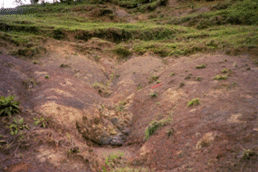Soils
The broad dissemination of soil sediments with thick layers and sharp boundaries to the saprolite or C-horizons detected in the Gina River catchment can give the indication that those soils did not develop in-situ. Instead, soils from upper parts of the catchment were possibly worn during long lasting denudation processes and deposited as sediments. This can be attributed possibly to soil erosion.
The predominance of clay loams allover the Gina River catchment can be attributed to the chemical wheatering processes with actual clay mineral formation dominating wheathering and soil formation processes.
Clays occur where in-situ development is not very matured (on Mountain tops and in Undulating areas with eroded soils). These are characterised by
- considerable shrinking and swelling properties;
- a medium infiltration capacity in the upper layer and a low infiltration capacity in the lower layer resulting in enhanced surface runoff. This explains the coincidence of this soil category with the occurrence of soil erosion damages.
Alluvial deposition can explain the distribution of sandy loams around the Gina River catchment (Beck et al. 2004).
The results of the land use in the Gina River catchment are discussed next.

